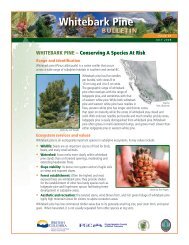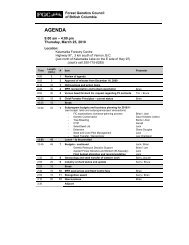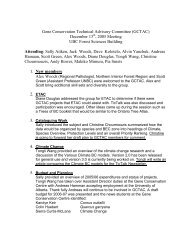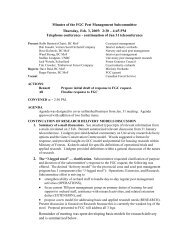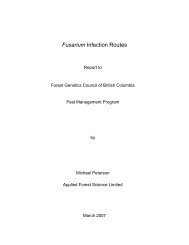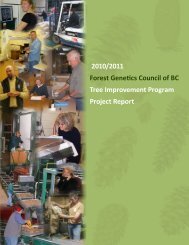Tree Improvement Program Project Report 2006 / 2007
Tree Improvement Program Project Report 2006 / 2007
Tree Improvement Program Project Report 2006 / 2007
Create successful ePaper yourself
Turn your PDF publications into a flip-book with our unique Google optimized e-Paper software.
slide monitor 4. Figure 31 shows the daily pollen catch in<br />
the WFP orchard 189. The monitor was adjacent to WFP<br />
slide monitor 8.<br />
The monitoring period was February 13 to March 13<br />
(note the monitor clock stopped for five days in orchard<br />
189) at WFP and February 11 to March 13 at TW. The<br />
receptivity period for WFP orchard 189 was February 20 to<br />
March 8, and at TW it was February 16 to March 5. Table<br />
9 shows the pollen load values for each of the three orchard<br />
sites, including the pollen load values calculated for WFP<br />
monitoring data for the two slide monitors (4 and 8). The<br />
7-day monitor was adjacent to each of the slide monitors,<br />
and pollen load values for the 7-day was 38 compared to<br />
160 at the reservoir site and 55 compared to 137 in the<br />
orchard. There are two important differences between these<br />
monitors. First the slides were located at 2 meters height<br />
whereas the 7-day monitors were placed at 3 meters height.<br />
Also the 7-day monitors are protected from the weather<br />
(capped), whereas the slides are exposed to the weather.<br />
Because this was the first time we compared side-by-side<br />
monitoring efficiencies, it is too early to suggest that one is<br />
better than the other.<br />
Figure 32 shows the daily pollen catch at the TW<br />
orchard 140. The pollen catch values were similar to those<br />
observed at WFP, but we do not have comparable data for<br />
TW western redcedar pollen monitoring.<br />
Conclus ons<br />
The magnitude and extent of western redcedar pollen<br />
on the Saanich peninsula was as great as for any coastal<br />
species monitored. However, since western redcedar pollen<br />
is among the smallest (30µ) of all local conifers, the error<br />
in counts will also be considerably higher than those for<br />
Douglas-fir, which is among the largest pollen grain of our<br />
local conifers (95µ).<br />
A second difficulty in counting western redcedar<br />
pollen is its size and form. It is very similar to red alder<br />
pollen. Western redcedar pollen is about 20 to 30 µ in<br />
diameter with some warty structures (orbicules) on the<br />
excine. At x100 magnification, it is possible to identify<br />
redcedar pollen, but it is very difficult to separate it from<br />
red alder pollen. Red alder is slightly smaller (20 to 25 µ<br />
in diameter) with pores. It looks very similar to redcedar at<br />
x100 magnification but with smaller orbicules. Positively<br />
distinguishing the two species at x400 is possible (glass<br />
slide and cover slip). However, distinguishing the two<br />
species at x400 on the Vaseline-coated charts (no cover slip)<br />
is very difficult. In general, the two are separated on the<br />
T R E E I M P R O V E M E N T P R O G R A M<br />
P R O J E C T R E P O R T 2 0 0 6 / 2 0 0 7<br />
basis of shape and phenology. When dry, redcedar pollen<br />
is irregularly shaped, and at X100, the orbicules appear<br />
as bright spots on the excine. Red alder is, in general,<br />
pentagonal and the orbicules do not appear as bright spots.<br />
However, when the two mix, it is not possible to determine<br />
the extent of either.<br />
Separation of redcedar pollen from red alder was<br />
particularly difficult in 2005 and <strong>2006</strong> because there<br />
was considerable overlap of shedding periods. However,<br />
in <strong>2007</strong> there was a clear separation between the end of<br />
redcedar pollen shed (March 6 to 10) and the start of red<br />
alder pollen shed. All data shown in Figures 29-32 are for<br />
redcedar pollen only.<br />
With the magnitude of pollen counts for western<br />
redcedar at both the monitoring sites, it is likely that<br />
significant contamination exists. This is certainly true<br />
for <strong>2007</strong> and 2005 when pollen capture levels were 3 to<br />
4 times that observed in <strong>2006</strong>. Whether this is a serious<br />
problem is not known. Certainly, any orchard clone sired<br />
with contaminated pollen should have a small positive<br />
effect over selfing. However, because the breeding value<br />
of contaminated pollen would be at best neutral, any<br />
contamination will have a negative effect on higherbreeding-value<br />
clones.<br />
This is the third year for monitoring western redcedar<br />
pollen shed from indigenous stands on the Saanich<br />
peninsula. However, the pollen monitoring technique used<br />
for Douglas-fir may not be applicable for western redcedar.<br />
The actual monitors do an excellent job of capturing the<br />
pollen, but the charts coated with Vaseline make positive<br />
identification difficult even with compound microscopes<br />
using x100 magnification. Data collected for <strong>2007</strong> also<br />
shows that there are considerable differences between<br />
the total pollen catch for slides and the catch for 7-day<br />
monitors. This will contribute to substantial error when<br />
calculating contamination values for redcedar orchards on<br />
the Saanich peninsula.<br />
L terature C ted<br />
Webber, J.E. and Painter, R.A. 1996. Douglas-fir pollen<br />
management manual. 2nd Edn. Ministry of Forests and<br />
Range, Research Branch. Work. Pap. 02/1996. 91pp.<br />
Woods, J.H., Stoehr, M.U., and Webber, J.E. 1996.<br />
Protocols for rating seed orchard seed lots in British<br />
Columbia. Ministry of Forests and Range, Research<br />
<strong>Program</strong>, Res. <strong>Report</strong> 06. 26pp.<br />
37



